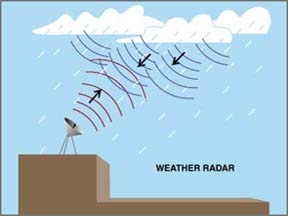Click on image for full size
Images Courtesy of NOAA Photo Library, NOAA Central Library; OAR/ERL/National Severe Storms Laboratory (NSSL), NASA, and National Weather Service Forecast Office of Milwaukee/Adam Harden
Related links:
Current U.S. Advisories/Watches/Warnings
Guide to Advisories, Watches, and Warnings
When Nature Strikes: Flash Floods!
When Nature Strikes: What Should You Do When Flash Floods Threaten? Classroom Activity
When Nature Strikes: Tornadoes!
When Nature Strikes: What Could You See as a Tornado Approaches? Classroom Activity
When Nature Strikes: Hurricanes!
When Nature Strikes: How Well Can Hurricane Tracks and Intensities Be Forecast? Classroom Activity
Examples of Advisories, Watches, and Warnings for Weather Events
Below is a list of some weather conditions that call for an advisory, watch, or warning.
Severe Thunderstorm Watch: A severe thunderstorm watch is issued when a thunderstorm with winds greater than 57 mph (92 kph) and/or hail with ¾ of an inch (19 mm) or more in diameter is possible
Severe Thunderstorm Warning: A severe thunderstorm warning is issued when severe thunderstorms have been seen or found on the radar. Once this warning has been issued, it is best to be prepared for lightning, heavy rain, strong winds, and large hail.
Tornado Watch: A tornado watch is issued when tornadoes may develop in a specific region within a certain time frame.
Tornado Warning: A tornado warning is issued when a tornado has been spotted or found on the radar. Shelter must be taken immediately.
Flash-flood Watch: Heavy rains in a specified area can cause flash flooding. A flood emergency may occur thus it is important to be alert and prepared to take action immediately.
Flash-flood Warning: A flash flood warning is issued when a flash flood is occurring or very probable in a certain area. Immediately move to safe ground.
Hurricane Watch: A tropical storm or hurricane is a threat to coastal areas. Be prepared to take action if a hurricane watch is issued.
Hurricane Warning: A hurricane warning is issued when a storm will strike an area within the next twenty four hours. Wind speeds will be greater than 74 mph (119 kph).
Winter Weather Advisory: A winter weather advisory is issued when a low pressure system creates hazardous winter weather such as snow, freezing rain, or sleet.
Winter Weather Watch: A winter weather watch is issued when there is potential for heavy snow or large ice accumulations. The watch is typically given out 24-36 hours in advance. Criteria for a watch vary in different places.
Winter Storm Warning: This warning is issued when a winter storm is producing or is forecasted to produce heavy snow or large ice accumulations. Criteria for a warning vary in different places. Blizzard Warning: A blizzard warning is issued when there is falling or blowing snow and winds of 35 mph (56 kph) or more, causing visibility to be less than ¼ mile (.4 km) for several hours.















